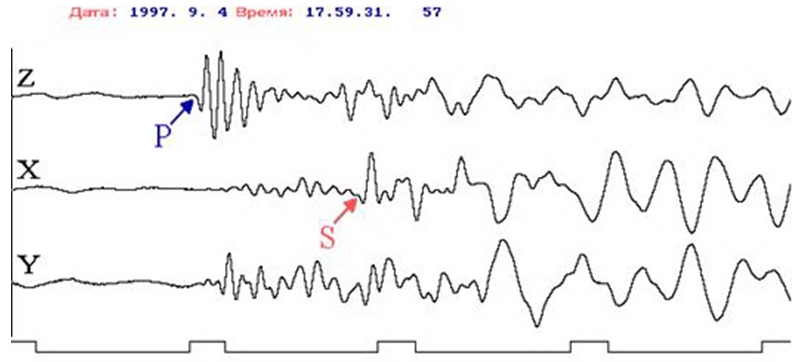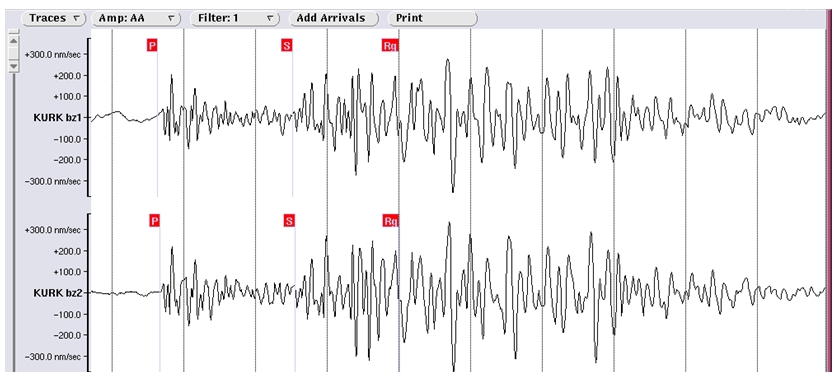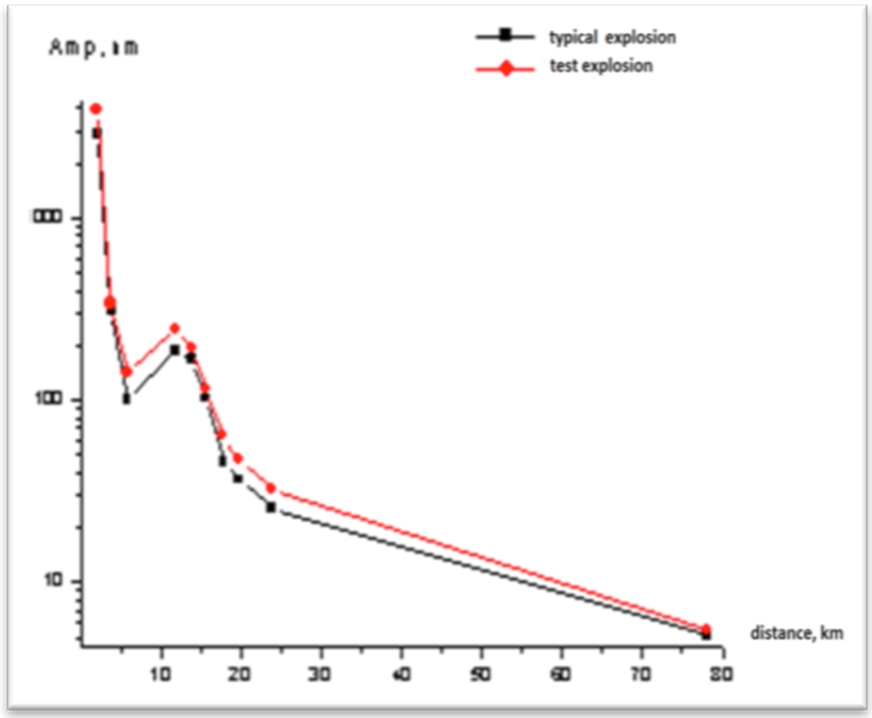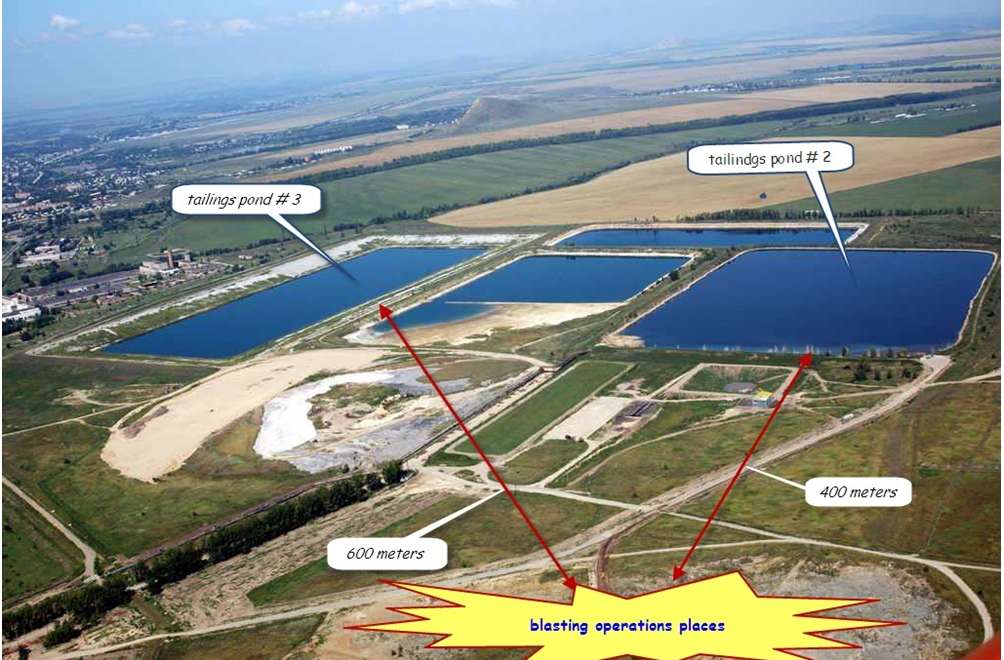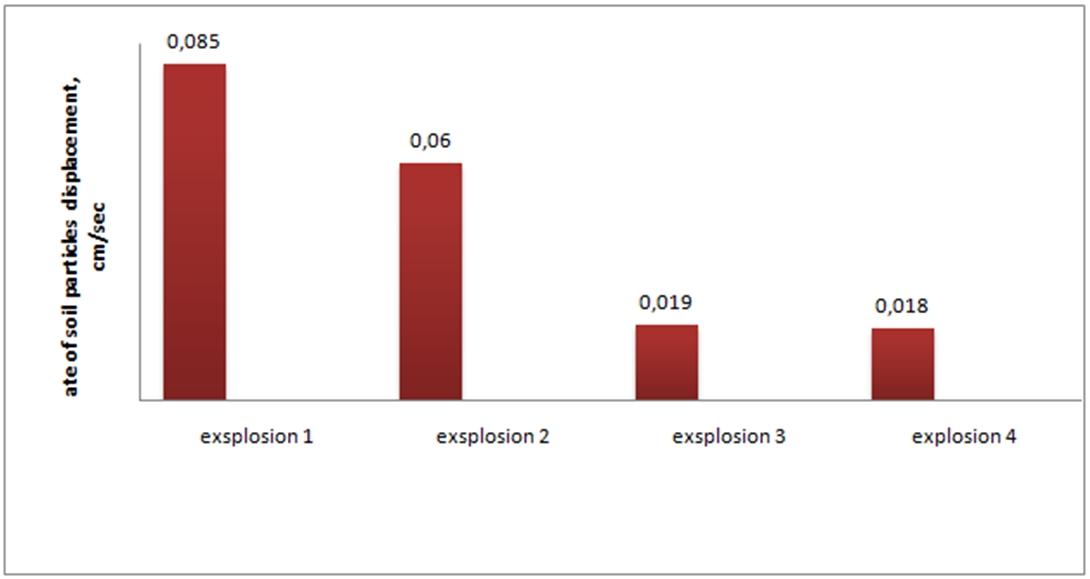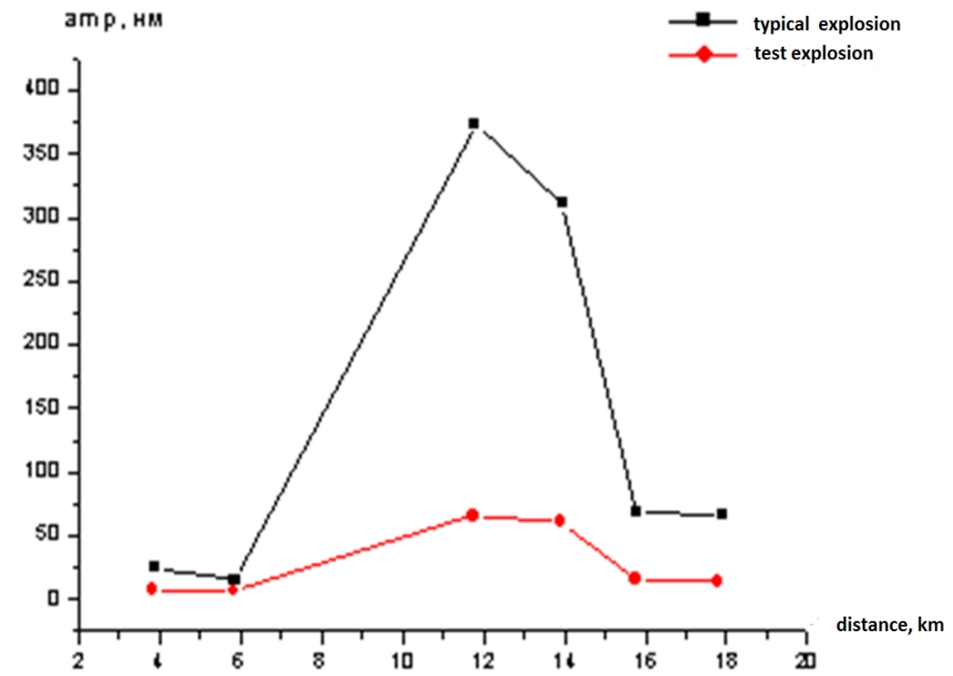БАЛАНСИРОВКА ВЗРЫВА
Григорьев С.И.
Государственный инспектор Департамента по ЧС Восточно-Казахстанской области МЧС Республики Казахстан, горный инженер-взрывник по открытым горным работам, Единая книжка взрывника с правом производства взрывных работ с 1972 г., аттестованный инспектор-взрывник Госгортехнадзора СССР с 1988 г.
БАЛАНСИРОВКА ВЗРЫВА
Аннотация
Рассмотрены практические результаты воздействия сейсмических волн промышленных взрывов на дробление горных пород и на безопасность зданий и сооружений, воздействие ударных воздушных волн. Результаты сравнительных промышленных взрывов показали, что наиболее оптимальным вариантом проведения взрывных работ является применение способа «Точка равновесия взрыва».
Ключевые слова: точка равновесия взрыва, инициирование заряда ВВ, взрыв, взрывные работы, энергия взрыва, сейсмическая волна.
Grigoriev S.I.
Chief specialist, Emergency and Industrial Safety State Inspection and Supervision Administration, East-Kazakhstan Region ED
Abstract
The article covers practical results of industrial blasting seismic waves’effect to crushing of roc and safety of buildings and structures. Results of comparative industrial blasting approved that the application of “blast balance point” method is the most optimal for blasting operations.
Keywords: blast balance point, initiation of EM charge, blast, blasting operations, blast energy, seismic wave, blast coefficient of efficiency.
Gun powder invented in ancient China was the first space-effective and powerful energy source. Later, explosive materials appeared, such as trotyl, which were incomparably much more destructive. Today, among the applied EM trotyl is the most well-known (trinitrotoluene, TNT, tolite). In order to blast the TNT we need an initiator — blast of more sensitive EM (detonator).
Explosive materials are easy to compare by specific energy, calculated for mass unit. Characteristic quantity is 1 kcal/g, or 4.2 kJ/g which corresponds to trotyl specific energy. Almost all commercially produced EM are around the energy value. We should remark that the energy is potential or thermal as EM producers call it, and is constant for each EM type. It is clear that only in significant quotum of all thermal energy is consumed for useful blast action. To improve the blasting characteristics, it is important to balance kinetic energy of blasting, specifically, useful energy acting to rock mass crushing.
Since energy does not vanish or arise, but can transfer from one type to another in equivalent quantity.
Blast Energy
Blast is a rapid energy release. High yield of the blast indicates quick reaction. Such quick blasting is called detonation. Detonation is spread by shock wave – immensely strong and sharp compression of explosive. Growth of pressure, density and temperature beyond the wave front starts quick reaction. Stable complex is formed, that is detonation wave consisting of shock wave followed by chemical reaction zone (ZND detonation model for the names of Y.B.Zel’dovich, John von Neumann and W. Doring). There at mechanical waves are formed which after blasting spread in earth’s crust stratum, and are called seismic waves. Seismic waves are the complicated form of energy transfer in environment, as only two external mechanical action resistance types are possible in solid bodies: volume change resistance and shear resistance. Therefore, seismic waves can be longitudinal (longitudinal waves, Р-wave, longitudinal wave) and shear (shear wave, S-wave, secondary wave), Fig.1.
Fig. 1 - Fragment of seismic record of borehole EM charge blasting. Arrival time of seismic waves to the observation point for longitudinal P- and shear S- waves (Z–vertical, X and Y–horizontal constituent of seismic detector)
The Figure 1 shows that velocity of Р-wave is much higher than of S-wave. Intensity of vertical constituent is much lower than that of horizontal constituent. This indicates horizontal polarization of wave field, that is, most quantity of seismic energy is in horizontal constituent of the wave field (useless form of mechanical work).
Seismic wave effect to the rock is shown in the figure 2 below.
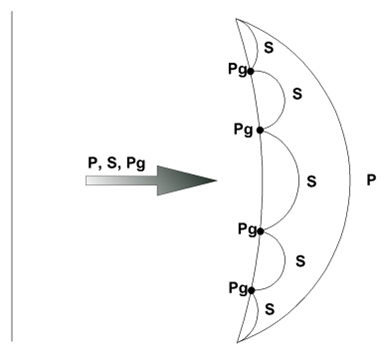
Fig. 2 - Types of elastic seismic waves. Р – longitudinal wave front, S – shear wave front, Рg– points of Rayleigh wave formation
Also it is determined that Р-wave carries about 6-8% of source energy, S-wave -23-26% and, finally, maximum energy (and minimum velocity, accordingly) from blast source (seismic event) is carried by Rayleigh surface waves -Рg - 66-70%.
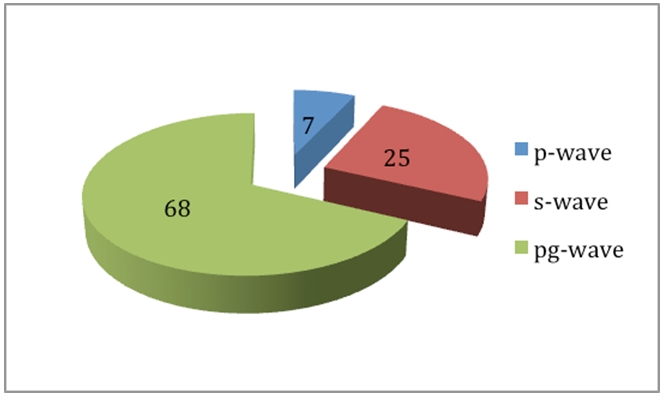
Fig. 3 - Bar diagram of blast specific energy by seismic waves
In this particular case we are interested in kinetic energy which is carried by Р-wave and partially by S-shear wave, that is, there is aback up which can be directed to increase blast energy for rock mass crushing using additional parameter –optimal location of EM initiation point [1], as according to the energy conservation law, with increase of Р and S wave energy, harmful effect of destructive Rayleigh surface waves will decrease correspondingly.
We should mention that structure of the registered bodily longitudinal waves is complicated. Three arrivals of Р-waves are observed: low-frequency first arrival (“acceleration”), in a second after – high-frequency second arrival Рn (shock wave) and, finally, in 10-12 seconds Рg-wave (surface). Within the 10-12 seconds a rumble sounds.
Seismic energy released from the blast source can be conditionally calculated using the notion energy class К, which characterizes earthquake (blasting) source. This is the characteristic directly related with the energy of seismic waves released as a result of blasting (earthquake). Compression and shear of rock mass is characterized by seismic event magnitude M. Seismic event magnitude (М, from Latin magnitudo - value) is a quantitative characteristics of earthquake source value, determined using earthquake records (seismographic record) at seismic stations. This is dimension less characteristic which enables to compare earthquake sources by their seismic energy. Magnitude is determined by bodily waves, mainly by P-waves at a distance over 20°. In order to determine energy class we need maximal amplitude in Р- and S- phase at SKM type short-period channels.
Thus, two scales are applied for energy and magnitude classification of chemical blasting – energy class К and magnitude M.
Earthquake energy classes vary within the range from 0 to 18-20. In the world in order to convert magnitudes to energy classes (К), the formula given below is taken:
К=4+1.8М (1)
In its turn, energy class is associated with seismic energy Еsin a simple ratio:
Еs = 10К, (J) (2)
Hence, on the basis of seismic event magnitude M, we can calculate energy class K for any seismic event including industrial blast, and even released seismic (kinetic) energy from blast source, earthquake.
Subject of Research
During industrial mass explosions conduction at the day surface detonator location point for initial impulse (initiation), hereafter referred to as explosive material EM, in a borehole is taken in two options: lower (reverse) in most cases; and more rarely upper (direct). However, nowadays, there are no definite calculations on detonator location point in EM borehole charge along its explosive column (length). In project documentation, as a rule, so-called typical location of detonator is assumed in EM charge, in other words, detonator is located “by eye” – in the lower part of borehole at the level of bench bottom, in the upper part – 0.5-1.5 m lower than high bound of charge column in the borehole.
Professor B.N.Kutuzov, for instance, recommends as follows: “…today borehole charges in open-pits are initiated by one or two blasting cartridges, located in the lower (at the level of bench bottom) and in the top (1.0-1.5 from head top) load” [2]. Principal attention should be given to initiation place. Depending on initiation point, compression wave velocity in rocks, also known as longitudinal (primary) wave or P-wave, directly affects the explosion quality.
In existing practice under EM charge location point “by eye” (in the lower, in the upper, in the center and counter initiation) we can get partial yield of explosion: weakened blows of blast wave “after”, or counterblows “end-on”, that considerably restrain blast waves and subsequently explosion yield, which is aimed at rock crushing.
Therefore, it is logically to suppose, that there is to be a pertinent point of application (initiation) of blast pulse to EM charge column, affecting the detonation stability.
Practical results of EM borehole charge initiation will be considered further below with application of “blast balance point” method.
Balancing of Compression and Fracture Energy of Р and S Seismic Waves
In 2011 in the East Kazakhstan Region two mass blastings were conducted at the open-pit coal mine “Karazhyra”. One was standard with EM total weight of 13320 kg, the other -experimental one with EM total weight of 14058 kg by application of blasting method in “blast balance point”.
Environment impact character is as follows – relieving charge, explosion of which breaks massif around the charge and causes splitting a part of the massif near the opened surfaces without joining of these two collapsing areas.
Explosive units of standard and experimental blasts were analogous upon explosion geometry (borehole diameter, EM charge, bench height, borehole spacing and so on), characteristics of detonated rocks, capability and types of explosive materials; explosion ground zeros were close to each other upon geographic location. The difference of explosions conducted was, that during standard blast typical location of primer “by eye” was applied with application of direct and counter initiation for principal EM charge initiation in borehole. During experimental blast detonator is located in a borehole according to “blast balance point” [5] (Figure 4).
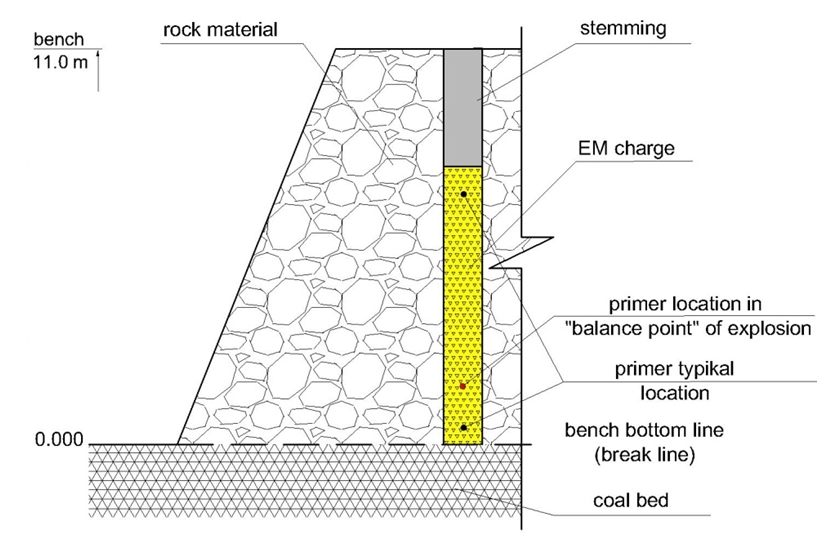
Fig. 4 - Schemes of Detonators Arrangement during Typical Explosion (black points), during Experimental Explosion (red point)
During experiments conduction by Institute of Geophysical Researches of the Republican State Enterprise National Nuclear Center of the Republic of Kazakhstan (IGR NNC RK) the profile of field seismic stations was set 200m - 24km away from open-pit coal mine. Stations were equipped with DAS-6102 PMD/eentec 24 discharge digitizer, made in USA (Fig.5), SK-1P three-component narrowband seismic detectors (Fig.6) and CMG40-T (Fig.7), which were used as seismometers.
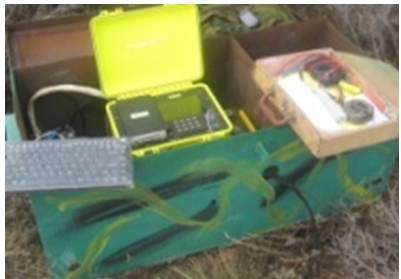
Fig.5 - Box for Digitizer, Power Unit and Accumulator
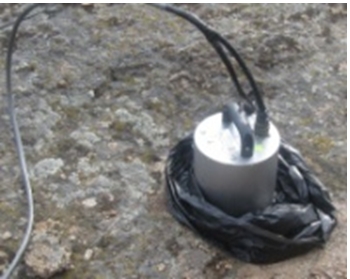
Fig.6 - CMG40T Seismometer
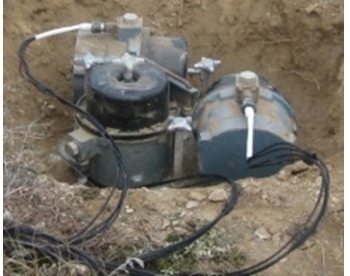
Fig.7 - SK-1P Seismometer
The above shown devices are capable to three-component registration of seismic signals (two horizontal components and vertical one). Moreover, CLA100 accelerograph of strong motions was installed at the open-pit near the ground zero of blast.
Blasts were also registered at the distance ~ 80 km away from the stationary monitoring network station of IGR NNC RK.
Figure 8 presents an explosion map of seismic stations, as well as a number of stationary stations of IGR NNC RK.
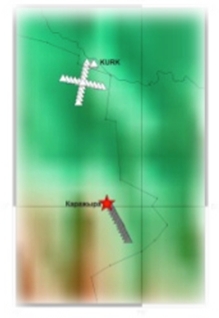
Fig. 8 - Map of Explosions Conduction – star, field stations – gray triangles, «KURK» Stationary Network of IGR NNC RK – white triangles
Character of body waves registering at each station for both blast types is analogous, however amplitude of experimental blast is a little greater than of standard one [5]. Wave pattern is observed for both events, standard for open-pit blasts, clear arrival of P (longitudinal) wave, shock Рg-wave, as well as occurrence of acoustical signal (impulse air wave) are observed on all records.
Figure 9 presents seismic records of standard and experimental blastings along Z-component of KURK station, filtered by SKM filter.
Fig. 9 - Seismic Record of Typical (upper record) and Experimental (lower record) Explosions. Z-Component. KURK Station, SKM Filter.
Amplitudes were measured for all stations after narrow-band frequency filtering by the filter with center frequency of 5.0 Hz.
Amplitude decay dependence on longitudinal P-wave distance is shown in the Figure 10.
Fig. 10 - Amplitude Decay P-Wave with Distance. Filter of 5 Hz
For both blasts dynamic parameters of magnitude М and energy class K were defined. Magnitude and energy class for standard and experimental blastings are shown in Table 1.
Table 1
| Station | Distance, km | М Standard blast | K Standard blast | М Experimental blast | K Experimental blast |
| S09 | 15.7 | 2.90 | 6.60 | 2.96 | 6,79 |
| S16 | 17.8 | 2.74 | 7.23 | 2.82 | 7,33 |
| S17 | 19.8 | 2.61 | 6.19 | 2.71 | 6,38 |
| S19 | 23.9 | 2.51 | 6.41 | 2.56 | 6,45 |
| KURK | 78 | 2.78 | 6.94 | 2.81 | 6,99 |
| Average values | 2.708 | 6.674 | 2.772 | 6.788 | |
| Discharged seismic energy Es | 4720630 J | 6137620J | |||
Table 1 shows magnitudes and energy classes of the standard and experimental blasts, calculated for different stations, and also average values. The standard blast magnitude comprised 2.71, of experimental one – 2.78, energy class of the standard blast K=6.67, of experimental one – K=6.79. It is also observed that the released underground seismic energy of the experimental blast increased by 30%.
Energy balancing of surface Pg seismic waves.
There were blasting operations in 2010-2011 at the construction stone Skalnoye deposit within the Ust-Kamenogorsk industrial area in the East Kazakhstan Oblast. There are also located the evaporation ponds with production liquid wastes from one of the city metallurgical plants. The total volume of the tailing dump ponds is about 10 million m3. The rocky ground serves for evaporation pond reconstruction. The year volume of rocky ground necessary for reconstruction is estimated as ~ 80000 m3.
The nearest dam board at the pond #2 is within 400 m from the coyote blast conduction area (Fig. 11).
For calculation of the blast seismic effects on the guarded sites (ponds) the project prescribes, on the basis of the RSE Kazakh State Blasting Center of the Republic of Kazakhstan final report, that a blast block shall be less than 2000 kg EM taking into account the distance to the guarded sites and structures remoteness from the blasting area.
Fig.11 - Overall View from the Satellite at the Guarded Structures – Evaporation Ponds and Blasting Area
The seismic activity of the hydraulic structures (ponds) caused come concern, those that are located within the immediate proximity to the blasting area considering multiple blast exposure.
It shall be taken into account that the accepted criteria for seismic hazard evaluation from the industrial blast is a damage caused by the ground shaking, connected with surface seismic Pg-waves. The most important characteristics of the seismic waves are the energy, impulse and velocity. Thus, by measuring Pg-wave velocity after blasting, it is possible to forecast the damage to buildings and structures. By international classification, the ground velocity of 5 cm/sec limits considerably safe zone from the probably hazardous one [7]. By Russian classification, the maximum allowable ground velocity values for the ground and underground guarded structures in our case are 1-3 cm/sec [8].
As a result, a decision was taken to accomplish activities aimed at prevention and reduction of the deleterious effects from hazardous production factors and their consequences: during blasting of every explosive block in the mine, in order to reduce energy of the surface seismic wave Pg in front of the guarded structures (ponds №№ 2,3), a contour slot of first split-off shall be foreseen, parallel to the front of the tailing dump pond which serves as a screen for seismic waves; additionally, for the purpose of blast balancing, the explosive material charge with detonator shall be initiated at the “blast balance point”.
The seismic monitoring in the territory where blasting was conducted was participated by the RSE KazNIISSA (Kazakh Research and Design Experimental Institute of Earthquake –Resistant Construction and Architecture in Almaty). The operations on seismic monitoring were performed using the digital RSM-8 system, as for measuring the acceleration along ground displacement, as for measuring the acceleration caused by the Earth gravity.
At conduction of test blasting of 535 kg EM and standard 1415 kg EM, the RSE KazNIISSA measured amplitudes of the acceleration and ground velocity at hydraulic structure at pond №2, located within 400 m from the blasting area [8]. At conducting the experimental blasts, the seismic measurements were taken at pond №2 and additionally at the pond №3, located within 600 m from the blasting area [9].
The blasted slot of preliminary split-off was used for the test blast of 535kg EM. At that, seismic effect in the ground on the dam body, exited by the test blast of 535kg EM comprised by the Russian intensity 12-grade MSK-64 scale (Medvedev-Shponhoyer-Karnik) below 3 grades (ground velocity in the dam basement was 0.045 cm/sec), for standard blast of 1415 kg EM – about 3 grades (ground velocity in the dam basement comprised 0.07 cm/sec).
The third and fourth experimental blasts were conducted by the “Blast balance point” method and additionally with originating a slot of first split-off.
In particular, for the test blast, the blast wave reaching for the dam basement of the lagoon at pond №2 at a velocity of 0.045 cm/sec (below 1 grade) induced fluctuation of water mass (around 2.0 mln. m3) which in turn swung the dam body at a velocity of 0.06 cm/sec (around 3 grades). The maximum acceleration of the dam (standard blast) comprised 7.95 cm/sec2 that corresponded to 3 grades. The following 3rd and 4th experimental blasts showed amplitude values of maximum impact at the dam body – in case of 0.013 cm/sec2 acceleration - about 2 grades, velocity of 0.022 cm/sec – about 2 grades [10].
For all blasts the prepotency of horizontal components of surface seismic Pg waves was registered. The character of recording the surface waves at all 4 blasts was similar, however, the amplitudes of the surface Pg-waves during the experimental blasts were lower than during typical and test blasts.
The instrumental data for seismic effects on dams at the guarded structures (ponds) from the performed blasts are shown in Table 2.
Table 2
| Blast № | Blast description | EM consumption per a blast, kg | Pg wave acceleration, сm/sec2 | Рg waves velocity, сm/sec | Dam displacement, сm | MSK-64 scale grades |
| 1 | Standard | 1415 | 7.95 | 0.085 | 1.5 | > 3 |
| 2 | Test with blasted slot | 535 | 3.9 | 0.06 | 1.2 | ~ 3 |
| 3 | Experimental for pond №2 | 1284 | 0.01 | 0.018 | no | ~ 2 |
| 4 | Experimental for pond №3 | 1260 | 0.013 | 0.019 | no | ~ 2 |
Analyses of the obtained data for acceleration and ground velocities showed the decrease in surface seismic Pg-wave energy. Figure 12 shows histogram of the standard, test and experimental blasts by seismic receiver X-component i.e. in the line from the dams to the blast.
Fig.12 - Histogram of the Performed Standard, Test and Two Experimental Blasts at Skalnoye Deposit
The histogram shows that none of the blasts reached the ground velocity values of 1-5 cm/sec, which limits considerably safe zone from the probably hazardous zone. At that, according to the RSE KazNIISSA reports, during the experimental blasts, there was an insignificant seismic effect around 2 grades (ground velocity in the dam basement comprised 0.022 cm/sec), and correspondingly, there was no dam body displacement, uniform improved crushing of rock, “soft” effect on the environment.
In the end of 2011, an independent specialized organization carried out an additional expertise in the evaporation ponds with liquid industrial wastes. As a result, it was determined that the technical condition of the evaporation ponds (ponds №№ 2, 3) with liquid industrial wastes corresponded to the industrial safety standards.
Balancing of Air-Blast Energy
However back to our blasts at coal strip mine “Karazhyra”.
Acoustic signal velocity is for standard blast v=331 m/s, for experimental blast v=336 m/s. Please note, that usual velocity of sound waves under air temperature is 18-200С – 1240 km/hour or 344 m/sec. As sound velocity in air depends on temperature so calculation is made by the following formula:
С = 331 (1+ Т/546), (3)
And, accordingly it is possible to “estimate” that air temperature near performance of blasting operations was about 3-60С. It is October, yet.
Table 3 presents amplitudes of acoustic signals measured on Z- component after filtration by narrow-band filter 5.0 Hz for standard and experimental blasts.
Table 3
| Station | Амр for standard blast, Nm | Амр for experimental blast, Nm | Ratio of Amp for acoustic signals |
| S07-PK | 373.00 | 65.40 | 5.703364 |
| S08-PK | 311.90 | 60.80 | 5.129934 |
| S09-PK | 68.30 | 15.90 | 4.295597 |
| S16-PK | 66.40 | 14.30 | 4.643357 |
| Average value of amplitudes ratio | 4.943063 | ||
As Table 3 shows upon seismic measures performed in some points of interim seismic stations network, acoustic (air-blast) wave Amplitudes (Amp) for standard blast are in average more than experimental one (Figure 13).
Fig.13 - Attenuation of Acoustic (air-blast wave) signal amplitudes with distance. Filter is 5 Hz, Z-component.
Conclusions
Consequently, the behavior for mechanical work of blast under blasting method is developed (and found out) in “blast balance point” allowing to increase kinetic energy of blast into useful form that is for breakage with relevant energy reduction of surfaced destructive Rayleigh waves and air-blast waves. Derivatives – increasing of industrial safety level and economic effect.
References
- Patent 25145 the Republic of Kazakhstan, KZ A4 F42D. Blasting Method of Extended Reach Boreholes / S.I. Grigor’yev; published by December 15, 2011, Bul. # 12 — 2011.
- N.Kutuzov. Blasting Operations Performance Methods, part 1, Mine Rock Destruction by Blast, Moscow, Mining Book, 2009, p.471.
- Surface mining New York. The American Institute of Mining, Metallurgial, And Petrolium Engineerings. Inc.. 1968, 455 p.
- Research and development report “Dynamic Characteristics Study of Quarry Blasts, October 5,6, 2011 at coal Karazhyra deposit”, inv.# 4-2012, UDC 550.334, 2012.
- Principal engineering material “Guidelines for Design and Performance of Blasting Operations under Reconstruction of Industry Enterprises and Civil Works” PEM 36.9-88, Moscow 1988
- Grigor’yev «Blast balancing». URL: http:// www.grisi.narod.ru .
- RSE KazNIISSA Report on Contract # 10-11/28/-04-01 dated March25, 2011. “Skal’noye” Deposit”. Seismic Monitoring of Territory under Blasting Operations Performance”.

